Nordmakedonien |
|
|
|
| Übersicht – Contents: | |
Nordmakedonien |
|
|
|
| Übersicht – Contents: | |
Flagge – Flag: |
|
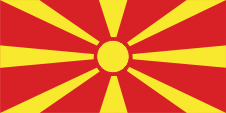 |
National-, Staats und Handelsflagge – national, state and merchant flag, Seitenverhältnis – ratio = 1:2, Quelle/Source, nach/by: Flags of the World   |
historische Flaggen – historical Flags: |
|
 |
1944, |
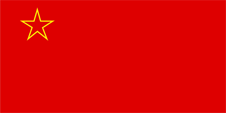 |
1946–1992, |
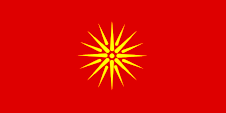 |
1992–1995, |
Bedeutung/Ursprung der Flagge – Meaning/Origin of the Flag: |
|
| Die heutige Flagge wurde am 06.10.1995 offiziell eingeführt. Sie zeigt eine stilisierte gelbe Sonne auf rotem Grund, deren Strahlen bis zum Flaggenrand reichen. Die Flagge erinnert an die vorhergehende Flagge (1992–1995) mit dem "Stern von Vergina". Vergina war die Hauptstadt des antiken Makedonien, das mit Griechenland verfeindet war. Die Farben der Flagge scheinen heute folgendermaßen definiert zu sein, und zwar hexadezimal: Rot = #D82126, was Pantone 1795 entsprechen würde und Gold = #F8E92E, was Pantone 107 entsprechen würde. | The
today's flag was officially introduced on 6th of October in 1995. It
shows a stylized yellow sun on red ground and its beams reach the border of
the flag. The flag remembers the preceding flag (1992–1995) with the "Star of Vergina". Vergina was the capital of the antique Macedonia, which coexisted in emnity with Greece. The colours of the flag seem to be defined today as follows, in hexadecimal: red = #D82126, which would correspond to Pantone 1795 and gold = #F8E92E, which would correspond to Pantone 107. |
| Wegen dieser Flagge kam es mit Griechenland zu Auseinandersetzungen, da Griechenland den Stern von Vergina, ebenso wie Makedonien, für sich beansprucht. Durch die Annahme der heutigen Flagge wurde dieser Streit beigelegt. |
Because of this flag there arised quarrels
with Greece, seeing that Greece claims the "Star of Vergina" for itself,
just as Macedonia. By the adoption of the today's flag this quarrel was terminated. |
| Makedonien hatte in seiner vor-jugoslawischen Geschichte offiziell keine eigene Flagge, wenn man vom kurzlebigen Unabhängigen Staat Makedonien absieht, jedoch sollen Makedonen in der Vergangenheit unter roten Fahnen gegen die Türken gekämpft haben. | Macedonia officially never had in its pre-yugoslav history an own flag, If you refrain from the short-lived Independent State of Macedonia, however the Macedonians should have fought in the past under red flags against the Turks. |
| Quelle/Source: Flags of the World, Flaggen und Wappen der Welt, Wikipedia (D) | |
Wappen – Coat of Arms: |
|
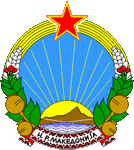 |
1944–1946, Wappen von Makedonien – coat of arms of Macedonia, Quelle/Source: MacedonianBoy [GFDL or CC BY-SA 4.0], from Wikimedia Commons |
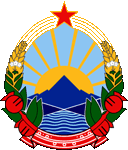 |
1946–1991, Wappen von Makedonien – coat of arms of Macedonia, Quelle/Source: Đorđe Andrejević-Kun & Antun August Augustinčić (supposed to be the original design authors), Cameltrader (original sVG file), CC BY-SA 2.5, via Wikimedia Commons |
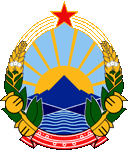 |
1991–2009, Wappen von Makedonien – coat of arms of Macedonia, Quelle/Source: Đorđe Andrejević-Kun & Antun August Augustinčić (supposed to be the original design authors), Cameltrader (original sVG file), CC BY-SA 2.5, via Wikimedia Commons |
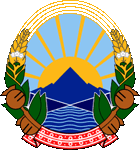 |
seit/since 2009, Wappen von Makedonien – coat of arms of Macedonia, Quelle/Source: MacedonianBoy [GFDL or CC BY-SA 4.0], via Wikimedia Commons |
Bedeutung/Ursprung des Wappens – Meaning/Origin of the Coat of Arms: |
|
| Das historische Wappen von Makedonien stammt aus dem Mittelalter und zeigt ein rotes Schild mit einem goldenen Löwen. Das heutige Wappen wurde am 27.07.1946 für das Sozialistische Makedonien als Teilrepublik Jugoslawiens eingeführt. Es zeigt ein Gebirge, hinter dem die Sonne aufgeht und im Vordergrund einen Fluss. Das Ganze ist umgeben von einem Kranz aus Getreideähren, Mohnstängeln und Tabakblättern. Am unteren Rand ein rotes Band mit einem volkloristischem Motiv. Weil das Wappen im Volk angeblich so beliebt ist, wurde es nach der Unabhängigkeit von Jugoslawien beibehalten. Aber wahrscheinlich wurde deswegen nicht zum historischen Wappen zurückgekehrt, weil es dem Wappen von Montenegro so sehr ähnelt. Am 16.11.2009 wurde rote Stern des Kommunismus vom Staatswappen entfernt. | The
historic coat of arms of Macedonia descents from the Middle Ages and shows a
red shield with a golden lion.
The today's coat of arms was introduced on the 27th of July in 1946 for the
socialistic Macedonia as partial republic of Yugoslavia. It shows mountains
behind them arises the sun and in the foreground a river. All this is
surrounded by a garland of wheat ears, poppy petioles and tobacco leafs. On the underneath border a red banner with a folkloristic depiction. That's because the coat of arms is ostensibly so popular with the people it was maintained after the independence from Yugoslavia. But probably they did not return to the historic coat of arms, because it is so similar to the coat of arms of Montenegro. On 16th of November in 2009 the red star of communism became removed from the coat of arms. |
| Quelle/Source: Flaggen und Wappen der Welt, Wikipedia (D) | |
Flugzeugkokarde – aircraft roundel: |
|
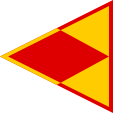 |
Flugzeugkokarde – aircraft roundel Quelle/Source: nach/by Wikipedia (EN) |
Landkarten – Maps: |
Lage – Position: |
Landkarte des Landes – Map of the Country: |
| Die Lage
Nordmakedoniens auf dem Balkan – The Position of North Macedonia on the Balkan |
|
Die
Staaten des früheren Jugoslawien – The countries of the former Yugoslavia: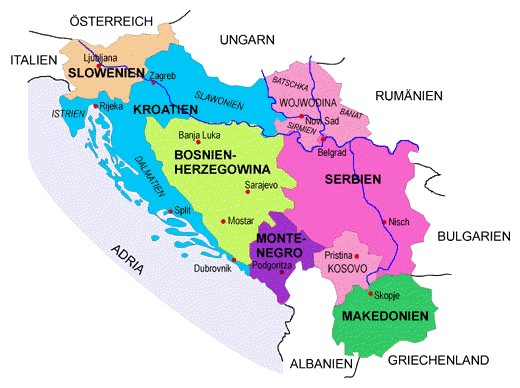 Landkarte/Map: Volker Preuß |
| Zahlen und Fakten – Numbers and Facts: | |
|
|
|
|
|
|
|
|
|
|
|
|
|
|
|
|
|
|
Geschichte: |
| 1200
v.Chr. · der griechische Stamm der Makedonen wandert in das von Illyrern,
Thrakern und Phrygen besiedelte Land ein 700 v.Chr. · die makedonische Dynastie der Argeaden herrscht über das Land 359–336 v.Chr. · Herrschaft von Philipp II. 336–323 v.Chr. · Herrschaft von Alexander III. (Alexander der Große), Sohn Philipps II., Makedonien wird ein Weltreich 13.06.323 v.Chr. · Tod von Alexander dem Großen in Babylon, Makedonien zerfällt 221–179 v.Chr. · Herrschaft von Philipp V. 215–205 v.Chr. · Erster Römisch-Makedonischer Krieg 200–197 v.Chr. · Zweiter Römisch-Makedonischer Krieg 171–168 v.Chr. · Dritter Römisch-Makedonischer Krieg, Makedonien verliert seine Unabhängigkeit und wird in vier Staaten aufgeteilt 148 v.Chr. · Makedonien wird römische Provinz 395 n.Chr. · bei der Teilung des Römischen Reiches kommt Makedonien an das Oströmische Reich (Byzanz) 6. Jhd. · slawische Einwanderung und Landnahme 969–1018 · Makedonien gehört zum Westbulgarischen Reich 1018 · Makedonien kommt wieder zum Oströmischen Reich (Byzanz) 1203 · Makedonien kommt zum Bulgarischen Reich 1389 · die Türken erobern Makedonien und gliedern es ihrem Osmanischen Reich ein 1913 · Erster Balkankrieg, Makedonien wird zwischen Griechenland, Serbien und Bulgarien aufgeteilt 1914 · Zweiter Balkankrieg, Bulgarien muss Teile seiner Makedonischen Gebiete an Serbien und Griechenland abtreten 1914–1918 · Erster Weltkrieg: Bulgarien gleicht 1915 durch eine Invasion in Serbien und Griechenland seine Gebietsverluste von 1914 aus, Stellungskrieg, eine im Oktober 1918 eingeleitete Invasion der Truppen der Entente drängt die bulgarischen Truppen zurück und stößt innerhalb von einem Monat durch ganz Serbien bis nach Belgrad vor, Serbien forciert die Einigung der südslawischen Völker unter seiner Krone im Staat "Königreich der Serben, Kroaten und Slowenen", das 1929 in Jugoslawien umbenannt wurde, Makedonien wird Bestandteil der Banschaft (Provinz) Vardar 1941 · Jugoslawien wird im Verlauf des Zweiten Weltkriegs aufgelöst, große Teile von Vardar werden von bulgarischen Truppen besetzt 1941–1946 · Jugoslawien ist während des Zweiten Weltkriegs Schauplatz eines erbarmungslosen Partisanen- und Bürgerkriegs zwischen Kommunisten (unter J.P.Tito), Republikanern, Monarchisten und Nationalisten, die Kommunisten setzen sich durch 02.08.1944 · Proklamation der Sozialistischen Republik Makedonien (innerhalb des kommunistischen Jugoslawiens) 1945 · Feststellung und Annahme einer standardisierten mazedonischen Sprache als Landessprache 29.11.1945 · Ausrufung der "Föderativen Volksrepublik Jugoslawien" (unter Einschluss Makedoniens) durch Tito 31.01.1946 · Proklamation der Volksrepublik Makedonien (innerhalb des kommunistischen Jugoslawiens) 12.04.1963 · Proklamation der Sozialistischen Republik Makedonien (within Yugoslavia) 25.01.1991 · Makedonien erklärt sich für souverän 07.06.1991 · Proklamation der Republik Makedonien 1991–1992 · Jugoslawien löst sich in seine Einzelstaaten auf (am 09.09.1991 Referendum in Makedonien für Souveränität, im November 1991 erhält das heutige Makedonien eine neue Verfassung und ist damit von Jugoslawien unabhängig) 1992 · Griechenland erkennt die Republik Makedonien wegen ihres Namens nicht an und verhängt ein Handelsembargo 1993 · Aufnahme Makedoniens als "Ehemalige Jugoslawische Republik Makedonien" in die UNO 1995 · Griechenland erkennt die Souveränität Makedoniens an, jedoch muss Makedonien seine Flagge ändern 1996 · Jugoslawien erkennt die Unabhängigkeit Makedoniens an 2001 · albanische Separatisten versuchen durch terroristische Aktionen und offenen bewaffneten Kampf Makedonien zu destabilisieren 12.06.2018 · Parlamentsbeschluss zur zukünftigen Umbenennung des Landes in Republik Nordmakedonien 12.02.2019 · Umbenennung in Republik Nordmakedonien |
History: |
| 1200 B.C.
· the Greek tribe of the Macedones immigrates in the by Illyrians, Thrakians
and Phrygians populated country 700 B.C. · the Macedonian dynasty of the Argeades rules over the country 359–336 B.C. · reign of Philipp II. 336–323 B.C. · reign of Alexander III. (Alexander the Great), son of Philipp II., Macedonia becomes an empire 13th of June 323 B.C. · death of Alexander the Great in Babylon, Macedonia disintegrates 221–179 B.C. · reign of Philipp V. 215–205 B.C. · First Roman-Macedonian War 200–197 B.C. · Second Roman-Macedonian War 171–168 B.C. · Third Roman-Macedonian War, Macedonia loses its independence and becomes partitioned into four states 148 B.C. · Macedonia becomes Roman province 395 A.D. · at the partition of the Roman Empire Macedonia comes to the East Roman Empire (Byzantium) 6th cent. · Slavic immigration and land's grabbing 969–1018 · Macedonia belongs to the West Bulgarian Empire 1018 · Macedonia comes again to the East Roman Empire (Byzantium) 1203 · Macedonia comes to the Bulgarian Empire 1389 · the Turks conquer Macedonia and incorporate it in their Ottoman Empire 1913 · First Balkan War, Macedonia becomes partitioned between Greece, Serbia and Bulgaria 1914 · Second Balkan War, Bulgaria has to cede parts of its Macedonian territories to Serbia and Greece 1914–1918 · First World War: Bulgaria compensates by an invasion in Serbia and Greece in 1915 its in 1914 suffered territorial losses, positional war, an in October 1918 startet invasion of troops of the Entente pushes the Bulgarian troops back and advances within one month through whole Serbia to Belgrad, Serbia forces the unification of the South Slawic nations under its crown in the state "Kingdom of the Serbs, Croats and Slovenes", which was renamed in 1929 in Yugoslavia, Macedonia becomes part of the Province of Vardar 1941 · Yugoslavia gets dissolved during the Second World War, large parts of Vardar are occupied by Bulgarian troops 1941–1946 · Yugoslavia is during the Second World War location of a merciless partisan and civil war between communists (under J.B.Tito), republicans, monarchists and nationalists, the communists prevailed 2nd of August in 1944 · proclamation of the Socialist Republic of Montenegro (within communist Yugoslavia) 1945 · determination and acceptance of a standardized Macedonian language as country's language 29th of November in 1945 · proclamation of the "Federative People's Republic of Yugoslavia" (Macedonia included) by Tito 31st of January in 1946 · proclamation of the People's Republic of Macedonia (within Yugoslavia) 12th of April in 1963 · proclamation of the Socialist Republic of Macedonia (within Yugoslavia) 25th of January in 1991 · Macedonia declares its sovereignty 7th of June in 1991 · proclamation of the Republic of Macedonia 1991–1992 · Yugoslavia dissolves into its particular states (on the 9th of September in 1991 referendum in Macedonia for sovereignty, in November 1991 the today's Macedonia gets a new constitution and is in this way independent from Yugoslavia) 1992 · Greece not recognizes the Republic of Macedonia because of its name and imposes a trade embargo 1993 · adoption of Macedonia as "Former Yugoslav Republic of Macedonia" in the UNO 1995 · Greece recognizes the sovereignty of Macedonia, but Macedonia has to change its flag 1996 · Yugoslavia recognizes the independence of Macedonia 2001 · Albanian separatists try to destabilize Macedonia by terroristic campaigns and open armed struggle 12th of June in 2018 · parliamentary resolution on the future renaming of the country in Republic of North Macedonia 12th of February in 2019 · renamed in Republic of North Macedonia |
| Quelle/Source: Atlas zur Geschichte, Wikipedia (D), Discovery '97 |
| Der Name Makedonien geht auf den um 1200 v.Chr. in das Land einwandernden, aus dem nördlichen Thessalien kommenden, griechischen Stamm der Makedonen zurück. | The Name Macedonia has its roots in the in ca. 1200 B.C. into the country immigrating – from the northern Thessalia coming – Greek tribe of the Makedones. |
| Quelle/Source: Volker Preuß | |